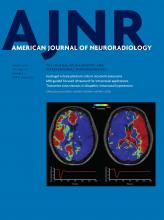Research ArticleNeurointervention
Flow Diversion in Ruptured Intracranial Aneurysms: A Meta-Analysis
T.P. Madaelil, C.J. Moran, D.T. Cross and A.P. Kansagra
American Journal of Neuroradiology March 2017, 38 (3) 590-595; DOI: https://doi.org/10.3174/ajnr.A5030
T.P. Madaelil
aFrom the Mallinckrodt Institute of Radiology (T.P.M., C.J.M., D.T.C., A.P.K.)
C.J. Moran
aFrom the Mallinckrodt Institute of Radiology (T.P.M., C.J.M., D.T.C., A.P.K.)
bDepartment of Neurosurgery (C.J.M., D.T.C., A.P.K.), Washington University School of Medicine, St. Louis, Missouri.
D.T. Cross III
aFrom the Mallinckrodt Institute of Radiology (T.P.M., C.J.M., D.T.C., A.P.K.)
bDepartment of Neurosurgery (C.J.M., D.T.C., A.P.K.), Washington University School of Medicine, St. Louis, Missouri.
A.P. Kansagra
aFrom the Mallinckrodt Institute of Radiology (T.P.M., C.J.M., D.T.C., A.P.K.)
bDepartment of Neurosurgery (C.J.M., D.T.C., A.P.K.), Washington University School of Medicine, St. Louis, Missouri.

References
- 1.↵
- Guglielmi G,
- Viñuela F,
- Dion J, et al
- 2.↵
- Wiebers DO,
- Whisnant JP,
- Huston J 3rd.
- 3.↵
- Pierot L,
- Spelle L,
- Vitry F, et al
- 4.↵
- Molyneux A,
- Kerr R,
- Stratton I
- 5.↵
- McDougall CG,
- Spetzler RF,
- Zabramski JM, et al
- 6.↵
- Brilstra EH,
- Rinkel GJ,
- Algra A, et al
- 7.↵
- Koivisto T,
- Vanninen R,
- Hurskainen H, et al
- 8.↵
- Yu SC,
- Kwok CK,
- Cheng PW, et al
- 9.↵
- 10.↵
- Becske T,
- Kallmes DF,
- Saatci I, et al
- 11.↵
- Petr O,
- Brinjikji W,
- Cloft H, et al
- 12.↵
- Di Maria F,
- Pistocchi S Clarençon F, et al
- 13.↵
- Kühn AL,
- Hou SY,
- Perras M, et al
- 14.↵
- Tanweer O,
- Raz E,
- Brunswick A, et al
- 15.↵
- Chalouhi N,
- Starke RM,
- Yang S, et al
- 16.↵
- Chalouhi N,
- Tjoumakaris S,
- Starke RM, et al
- 17.↵
- Kallmes DF,
- Hanel R,
- Lopes D, et al
- 18.↵
- 19.↵
- Saatci I,
- Yavuz K,
- Ozer C, et al
- 20.↵
- Fischer S,
- Vajda Z,
- Aguilar Perez M, et al
- 21.↵
- Proust F,
- Hannequin D,
- Langlois O, et al
- 22.↵
- Riley RD,
- Lambert PC,
- Abo-Zaid G
- 23.↵
- Çinar C,
- Oran İ,
- Bozkaya H, et al
- 24.↵
- Cruz JP,
- O'Kelly C,
- Kelly M, et al
- 25.↵
- McAuliffe W,
- Wenderoth JD
- 26.↵
- Lin N,
- Brouillard AM,
- Keigher KM, et al
- 27.↵
- 28.↵
- Nerva JD,
- Morton RP,
- Levitt MR, et al
- 29.↵
- Yoon JW,
- Siddiqui AH,
- Dumont TM, et al
- 30.↵
- Mahaney KB,
- Chalouhi N,
- Viljoen S, et al
- 31.↵
- Brasiliense LB,
- Stanley MA,
- Grewal SS, et al
- 32.↵
- Chiu AHY,
- Wenderoth J
- 33.↵
- Velat GJ,
- Fargen KM,
- Lawson MF, et al
- 34.↵
- Cruz J,
- Chow M,
- O'Kelly C, et al
- 35.↵
- Cebral J,
- Mut F,
- Raschi M, et al
- 36.↵
- 37.↵
- Park MS,
- Kilburg C,
- Taussky P, et al
- 38.↵
- 39.↵
- 40.↵
- Siddiqui AH,
- Kan P,
- Abla AA, et al
- 41.↵
- Schievink WI,
- Wijdicks EF,
- Piepgras DG, et al
- 42.↵
- Brinjikji W,
- Murad MH,
- Lanzino G, et al
In this issue
American Journal of Neuroradiology
Vol. 38, Issue 3
1 Mar 2017
Advertisement
T.P. Madaelil, C.J. Moran, D.T. Cross, A.P. Kansagra
Flow Diversion in Ruptured Intracranial Aneurysms: A Meta-Analysis
American Journal of Neuroradiology Mar 2017, 38 (3) 590-595; DOI: 10.3174/ajnr.A5030
0 Responses
Jump to section
Related Articles
Cited By...
- Flow diversion with hydrophilic polymer coating with prasugrel as single antiplatelet therapy in the treatment of acutely ruptured intracranial aneurysms: a multicenter case series, complication and occlusion rates
- Evaluation of flow diverters for cerebral aneurysm therapy: recommendations for imaging analyses in clinical studies, endorsed by ESMINT, ESNR, OCIN, SILAN, SNIS, and WFITN
- Safety and efficacy of coated flow diverters in the treatment of ruptured intracranial aneurysms: a retrospective multicenter study
- Derivo embolization device for intracranial aneurysms: a Spanish multicenter retrospective study
- Flow Diversion in the Treatment of Intracranial Aneurysms: A Pragmatic Randomized Care Trial
- Finnish flow diverter study: 8 years of experience in the treatment of acutely ruptured intracranial aneurysms
- Antiplatelet Management for Stent-Assisted Coiling and Flow Diversion of Ruptured Intracranial Aneurysms: A DELPHI Consensus Statement
- Use of the pCONus HPC as an adjunct to coil occlusion of acutely ruptured aneurysms: early clinical experience using single antiplatelet therapy
- Republished: Competitive flow diversion of multiple P1 aneurysms: proposed classification
- Competitive flow diversion of multiple P1 aneurysms: proposed classification
- Flow diversion treatment for acutely ruptured aneurysms
- Flow diversion beyond the circle of Willis: endovascular aneurysm treatment in peripheral cerebral arteries employing a novel low-profile flow diverting stent
- Acutely Ruptured Intracranial Aneurysms Treated with Flow-Diverter Stents: A Systematic Review and Meta-Analysis
This article has not yet been cited by articles in journals that are participating in Crossref Cited-by Linking.
More in this TOC Section
Similar Articles
Advertisement











